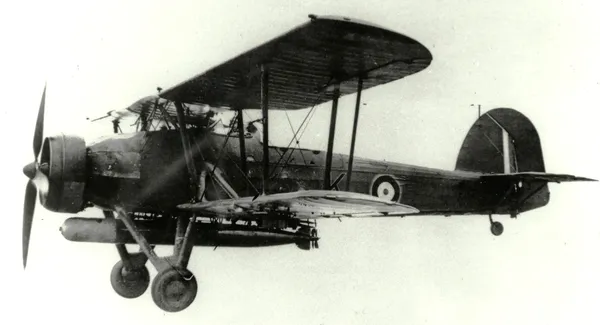Hoar, Donald Roderick (Lieutenant)
Killed in Action 1941-January-14


Birth Date: 1915
Born:
Parents:
Spouse:
Home: Calgary, Alberta
Enlistment:
Enlistment Date: unkown date
Service
RN FAA
Unit
824 Sqn- Squadron
Base
Rank
Lieutenant
Position
Pilot
Service Numbers
Home
Swordfish serial: P4270

Fairey Swordfish in flight ca. 1941
The Fairey Swordfish is a biplane torpedo bomber designed by the Fairey Aviation Company. Originating in the early 1930s, the Swordfish, nicknamed "Stringbag", was operated by the Fleet Air Arm of the Royal Navy, it was also used by the Royal Air Force (RAF), as well as several overseas operators, including the Royal Canadian Air Force (RCAF) and the Royal Netherlands Navy. It was initially operated primarily as a fleet attack aircraft. During its later years, the Swordfish became increasingly used as an anti-submarine and training platform. The type was in frontline service throughout the Second World War.
Despite being obsolete by 1939, the Swordfish achieved some spectacular successes during the war. Notable events included sinking one battleship and damaging two others of the Regia Marina (the Italian Navy) during the Battle of Taranto, and the famous attack on the Bismarck, which contributed to her eventual demise. By the end of the war, the Swordfish held the distinction of having caused the destruction of a greater tonnage of Axis shipping than any other Allied aircraft. The Swordfish remained in front-line service until V-E Day, having outlived multiple aircraft that had been intended to replace it in service.
The Fairey Swordfish was a medium-sized biplane torpedo bomber and reconnaissance aircraft. The Swordfish employed a metal airframe covered in fabric. It utilized folding wings as a space-saving measure, which was useful onboard aircraft carriers and battleships. In service, it received the nickname Stringbag; this was not due to its biplane struts, spars, and braces, but a reference to the seemingly endless variety of stores and equipment that the type was cleared to carry. Crews likened the aircraft to a housewife's string shopping bag, common at the time and which could accommodate contents of any shape, and that a Swordfish, like the shopping bag, could carry anything.
The primary weapon of the Swordfish was the aerial torpedo, but the low speed of the biplane and the need for a long straight approach made it difficult to deliver against well-defended targets. Swordfish torpedo doctrine called for an approach at 5,000 feet (1,500Â m) followed by a dive to torpedo release altitude of 18 feet (5.5Â m). Maximum range of the early Mark XII torpedo was 1,500 yards (1,400Â m) at 40 knots (74Â km/h; 46Â mph) and 3,500 yards (3,200Â m) at 27 knots (50Â km/h; 31Â mph). The torpedo travelled 200 feet (61Â m) forward from release to water impact, and required another 300 yards (270Â m) to stabilise at preset depth and arm itself. Ideal release distance was 1,000 yards (910Â m) from target if the Swordfish survived to that distance.
The Swordfish was also capable of operating as a dive-bomber. During 1939, Swordfish on board HMS Glorious participated in a series of dive-bombing trials, during which 439 practice bombs were dropped at dive angles of 60, 67 and 70 degrees, against the target ship HMS Centurion. Tests against a stationary target showed an average error of 49Â yd (45Â m) from a release height of 1,300Â ft (400Â m) and a dive angle of 70 degrees; tests against a manoeuvring target showed an average error of 44Â yd (40Â m) from a drop height of 1,800Â ft (550Â m) and a dive angle of 60 degrees.
After more modern torpedo attack aircraft were developed, the Swordfish was soon redeployed successfully in an anti-submarine role, armed with depth charges or eight "60Â lb" (27Â kg) RP-3 rockets and flying from the smaller escort carriers, or even merchant aircraft carriers (MACs) when equipped for rocket-assisted takeoff (RATO). Its low stall speed and inherently tough design made it ideal for operation from the MACs in the often severe mid-Atlantic weather. Indeed, its takeoff and landing speeds were so low that, unlike most carrier-based aircraft, it did not require the carrier to be steaming into the wind. On occasion, when the wind was right, Swordfish were flown from a carrier at anchor. Wikipedia